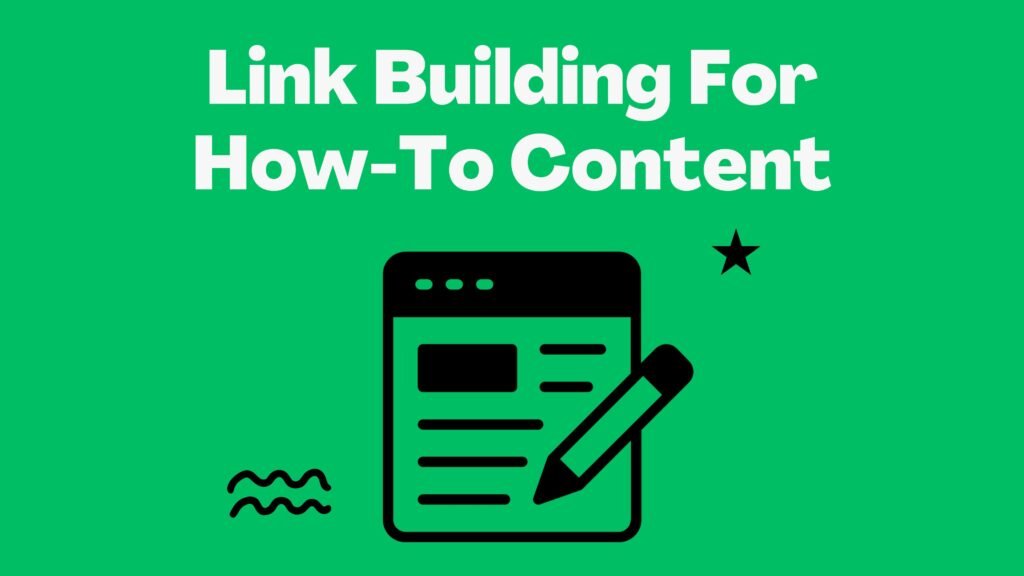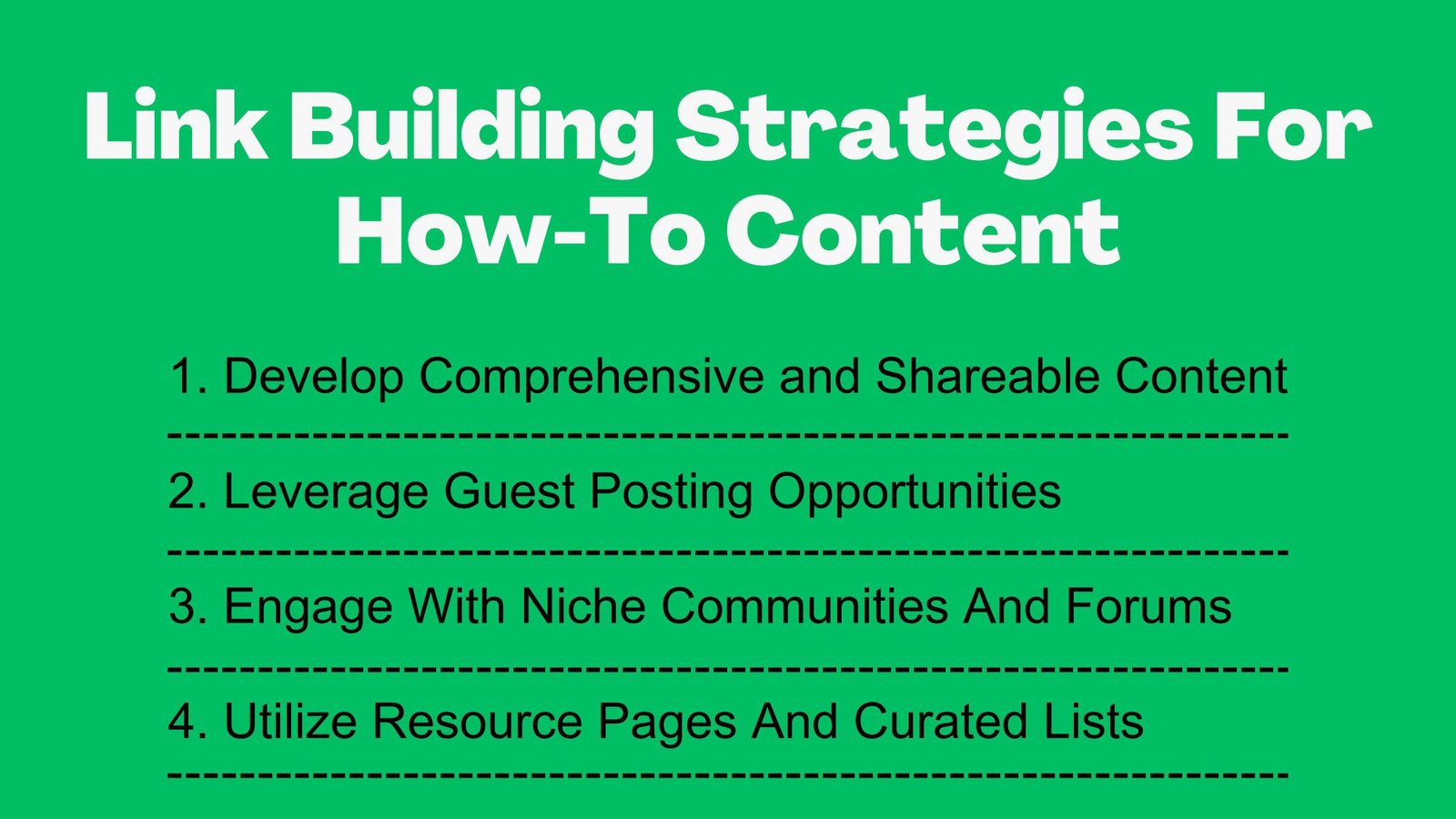
Link building is a crucial component of any successful SEO strategy, and when it comes to how-to content, it becomes even more essential. How-to articles are designed to provide readers with step-by-step instructions or guidance on a particular topic, making them highly valuable and shareable. However, to ensure that your how-to content reaches a wider audience and ranks well in search engine results, effective link building is necessary. In this article, we will explore the importance of link building for how-to content and provide actionable strategies to enhance your content’s visibility and authority.
The digital landscape is saturated with content, and standing out requires more than just high-quality writing. Search engines like Google use complex algorithms to determine the relevance and authority of web pages, and backlinks play a significant role in this process. Backlinks, or inbound links, are links from other websites that point to your content. They act as votes of confidence, signaling to search engines that your content is trustworthy and valuable. For how-to content, which often serves as a go-to resource for users seeking solutions, acquiring quality backlinks can significantly boost its search engine ranking.
To build a robust link profile for your how-to content, it’s essential to focus on creating content that is not only informative but also engaging and shareable. This involves understanding your target audience’s needs and crafting content that addresses their pain points effectively. Additionally, leveraging various link-building techniques, such as guest blogging, influencer outreach, and social media promotion, can amplify your content’s reach and attract authoritative backlinks.
Moreover, internal linking within your website can enhance the user experience and improve your site’s overall SEO performance. By strategically linking related how-to articles, you can guide readers through a comprehensive learning journey while signaling to search engines the interconnectedness and relevance of your content.
In conclusion, link building is a vital aspect of optimizing how-to content for search engines. By implementing effective link-building strategies, you can increase your content’s visibility, drive more organic traffic, and establish your website as a trusted resource in your niche. As you embark on your link-building journey, remember that quality always trumps quantity, and building genuine relationships with other content creators can lead to long-term success.
Why is Link Building For How-To Content Important?
Enhances Search Engine Visibility
Link building plays a crucial role in improving the visibility of your how-to content on search engines. When reputable websites link to your content, search engines interpret this as a sign of credibility and relevance. As a result, your content is more likely to rank higher in search results, making it easier for users to discover your guides and tutorials.
Builds Authority and Credibility
High-quality backlinks from authoritative sources signal to search engines and users that your content is trustworthy and valuable. This authority not only boosts your rankings but also encourages more users to engage with your content, share it, and reference it in their own work.
Drives Targeted Traffic
Links from relevant websites in your niche attract targeted visitors who are genuinely interested in your how-to content. This targeted traffic increases the likelihood of user engagement, such as time spent on your page, sharing your content, or converting into customers or subscribers.
Supports Content Discovery and Indexing
Search engines use links to discover new content. When your how-to articles are linked from other sites, search engines can find and index your pages more efficiently. This process ensures your content appears in search results faster and reaches a broader audience.
Encourages Content Sharing and Outreach
Effective link building fosters relationships with other content creators, bloggers, and industry influencers. These relationships can lead to more sharing, guest posting opportunities, and collaborations, further amplifying your reach and authority in the niche.
Improves Long-Term SEO Performance
While content quality is vital, consistent link building ensures sustained SEO benefits over time. As your content accumulates backlinks, its authority grows, helping it maintain or improve rankings even as search engine algorithms evolve.
Key Strategies for Link Building in How-To Content
- Create High-Quality, Shareable Content: Focus on producing comprehensive, easy-to-understand, and visually appealing guides that others want to reference and share.
- Reach Out to Industry Influencers: Connect with bloggers, YouTubers, and industry experts to share your content or collaborate on projects.
- Guest Posting: Write guest articles for reputable sites in your niche, including links back to your how-to content.
- Leverage Social Media: Promote your content across social platforms to increase visibility and encourage sharing, which can lead to natural backlinks.
- Participate in Relevant Communities: Engage in forums, Q&A sites, and online communities related to your niche, sharing your content where appropriate.
Effective link building for how-to content is essential for enhancing visibility, authority, and traffic. By implementing strategic outreach, creating valuable content, and fostering relationships within your industry, you can significantly improve your content’s SEO performance and establish a strong online presence.
Top Strategies For Link Building For How-To Content
 Creating effective backlinks for your how-to content is essential to boost visibility, authority, and traffic. When executed correctly, link building can significantly enhance the reach of your instructional articles by earning high-quality links from relevant sources. Below are proven strategies tailored specifically for promoting how-to guides through strategic link-building techniques.
Creating effective backlinks for your how-to content is essential to boost visibility, authority, and traffic. When executed correctly, link building can significantly enhance the reach of your instructional articles by earning high-quality links from relevant sources. Below are proven strategies tailored specifically for promoting how-to guides through strategic link-building techniques.
1. Develop Comprehensive and Shareable Content
A cornerstone of successful link building is producing valuable content that others want to reference or share.
- Create In-Depth Guides: Ensure your how-to articles cover topics thoroughly with step-by-step instructions, visuals, and expert insights.
- Incorporate Data & Research: Use original data or cite reputable studies; this adds credibility and encourages other sites to link back as a source.
- Add Visual Elements: Infographics, videos, diagrams—visuals make complex processes easier to understand and more likely to be shared.
- Why it works: High-quality resources naturally attract backlinks because they serve as authoritative references in the niche.
2. Leverage Guest Posting Opportunities
Guest posting remains one of the most effective ways to earn targeted backlinks while expanding your audience base.
- Identify popular blogs or websites within your industry that publish similar tutorials or educational content.
- Pitch unique ideas related directly to “how-to” topics you excel at creating detailed guides on.
- Include contextual links within guest posts pointing back toward specific sections of your own comprehensive guide pages where appropriate.
Tip: Focus on platforms with strong domain authority (DA) for maximum SEO benefit.
3. Engage With Niche Communities And Forums
Participating actively in online communities helps establish relationships that can lead organically into backlink opportunities:
Join Relevant Platforms:
- Reddit subreddits focused on DIY projects or technical skills
- Quora spaces answering questions aligned with your expertise
- Industry-specific forums
- Share Your Expertise: Offer helpful advice along with linking subtly back when referencing a particular method covered in detail elsewhere onyour site
- Build Trust Over Time: Consistent engagement increases chances members will cite you as an authoritative resource
4. Utilize Resource Pages And Curated Lists
Many websites maintain curated lists featuring top tools/resources/tutorials — these are golden opportunities:
• Reach out politely via email suggesting inclusion if you’ve created exceptional “how-to” content relevant thereto
• Highlight what makes yours stand out – clarity? depth? visual aids?
• Provide direct URLs leading straight towards key parts like downloadable templates/step-by-step breakdowns
This approach positions you as an expert worth citing.
5. Repurpose Content Into Different Formats To Attract Links
Transforming existing material into various formats broadens its appeal across different audiences:
- Convert lengthy blog posts into infographics summarizing main steps
- Create short video snippets demonstrating core procedures which can be embedded elsewhere
- Compile checklists based off tutorial points suitable for sharing/downloadability
- Sharing diverse versions enhances discoverability—and increases chances other creators/linkers find value enoughto embed/share.
6.. Build Relationships With Influencers And Bloggers
Connecting personally boosts trustworthinessand opens doorsfor collaboration:
• Comment thoughtfullyon theircontent
• Sharetheirpostswith attribution
• Invitethemto co-create newtutorial seriesor webinars
These interactions often resultin naturallink placementsas partof ongoing partnerships.
Effective link building around “How-To” content hinges upon providing genuine value combined with proactive outreach efforts.
By crafting thorough resources,your engaging authenticallywithin communityspaces,and leveraging multiple formats,you position yourself not just asa creator but alsoasa trustedindustry resourceworthyof citation.
Measuring & Analyzing Link Building For How-To Content Success
Effective link building for how-to content is essential to boost visibility, authority, and traffic. However, simply acquiring backlinks isn’t enough; you need a clear system to measure and analyze your efforts’ success. This section explores key metrics, tools, and strategies that help evaluate the impact of your link-building campaigns specifically tailored for instructional or tutorial-based content.
Key Metrics to Track in Link Building Campaigns
Understanding which data points matter most allows you to refine your approach continuously. Here are the primary metrics to monitor:
1️⃣ Backlink Quantity
The total number of backlinks acquired over time is an indicator of your outreach effectiveness. While numbers matter, they should not be the sole focus.
2️⃣ Backlink Quality
Not all backlinks are created equal. Focus on earning links from authoritative and relevant sites within your niche to pass meaningful SEO value.
3️⃣ Dofollow vs. Nofollow Links
Dofollow links transfer SEO authority, while nofollow links do not directly impact rankings. Monitoring the ratio helps assess the potential SEO benefit of your link profile.
4️⃣ Anchor Text Diversity
Diversified anchor texts help avoid spammy patterns and improve keyword relevance. Use a mix of branded terms, generic phrases (like “click here”), and descriptive text related to your content.
5️⃣ Referral Traffic
Measure the visitors arriving through backlinks. This indicates both the quality of your linking sites and how engaging your content is to external audiences.
6️⃣ Keyword Rankings
Track the ranking positions of keywords associated with your how-to content. Improvements often correlate with stronger backlink profiles.
7️⃣ Domain Authority (DA) / Domain Rating (DR)
A rise in these scores over time signals that search engines perceive your site as more credible and authoritative.
Selecting Tools to Analyze Your Backlinks Effectively
Choosing the right tools ensures accurate measurement without overwhelming complexity:
- Ahrefs: Offers comprehensive backlink analysis, including new/lost links, DR, and anchor text distribution.
- SEMrush: Provides detailed reports on referring domains and backlink health.
- Moz Pro: Focuses on DA trends and identifies high-value linking opportunities.
- Google Search Console: A free option that shows who’s linking to you, your top linked pages, and any manual actions affecting your site.
Review these tools regularly to identify strengths and opportunities for improvement.
Evolving Strategies Based on Data Insights
Data-driven decisions fuel long-term success. Here’s how to use insights effectively:
✅ Identify High-Performing Sources
Focus on referral sources generating valuable traffic or backlinks. Strengthen relationships with those websites for future collaborations.
✅ Assess Anchor Text Trends
Monitor anchor text diversity to ensure natural linking patterns and avoid over-optimization.
✅ Refine Outreach Efforts
Test different outreach messages and pitches. Double down on what works, and modify or drop underperforming tactics.
✅ Monitor Competitor Backlinks
Use tools like Ahrefs or SEMrush to analyze competitors’ backlink profiles. Find gaps and opportunities to secure similar high-quality links.
✅ A/B Testing and Continuous Improvement
Experiment with:
- Different email templates or outreach angles.
- Various resource types (e.g., infographics vs. blog posts).
- Track response rates and conversions to determine what resonates best.
Common Mistakes to Avoid While Link Building for How-To Content
1️⃣ Prioritizing Quantity Over Quality
Chasing large numbers of backlinks at the expense of quality can harm your SEO. Focus on acquiring links from trustworthy, relevant sites.
2️⃣ Ignoring Relevance and Context
Backlinks should come from sources closely aligned with your how-to topic. Irrelevant links confuse users and weaken SEO signals.
3️⃣ Overusing Exact Match Anchor Text
Excessive use of exact match anchors (e.g., “how to build a deck”) can trigger search engine penalties. Instead:
- Use branded names
- Include generic terms
- Opt for partial match anchors that read naturally
4️⃣ Neglecting Personalization in Outreach
Generic link requests often get ignored. Personalize emails by:
- Referencing the recipient’s content
- Highlighting shared interests or connections
- Building relationships rather than seeking one-time links
5️⃣ Failing to Monitor Backlink Profile Health
Unchecked toxic links can harm your rankings. Regular audits help identify and disavow harmful backlinks before they cause damage.
Additional Best Practices
Interlink older and newer tutorials to create a logical path for readers and enhance SEO crawlability.
Leverage local citations and partnerships if your how-to content has regional relevance (e.g., guides specific to local practices or regulations).
Promote via social media and email lists to increase content visibility and organic link opportunities.
FAQs About Link Building for How-To Content
What is the importance of link building for how-to content?
Link building improves your content’s authority, helps boost search engine rankings, drives targeted traffic, and increases your content’s visibility among people searching for practical solutions.
How can I identify high-quality sites to target for backlinks?
Use tools like Ahrefs or SEMrush to:
Check domain authority and relevance
Analyze competitors’ backlinks
Look for guest posting or resource page opportunities in your niche
What strategies work best for acquiring backlinks in the how-to niche?
Create comprehensive, well-researched guides.
Reach out with personalized guest post pitches.
Build resource pages and collaborate with influencers.
Develop visual content like infographics that naturally earn links.
How long does it take to see results?
It typically takes 3 to 6 months to see noticeable improvements in rankings from link-building efforts. Consistency and quality accelerate results.
Final Thoughts
Building links for how-to content is a long-term process that requires strategy, patience, and attention to quality. By focusing on relevant, authoritative links and continuously improving based on data insights, you can grow your site’s authority, search visibility, and audience trust.
